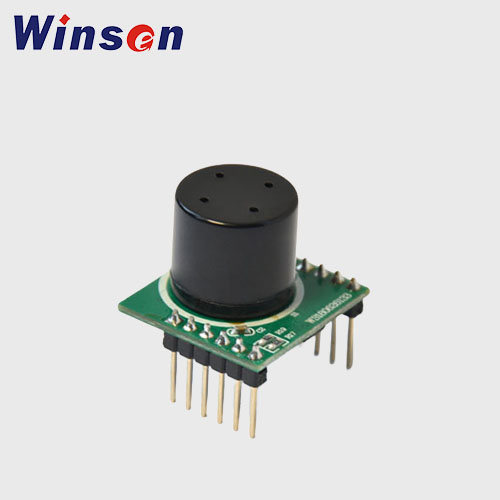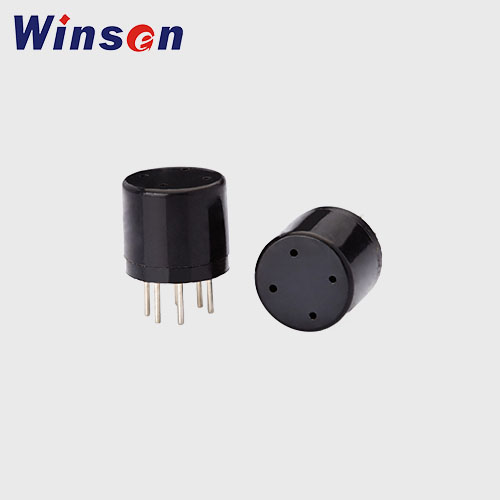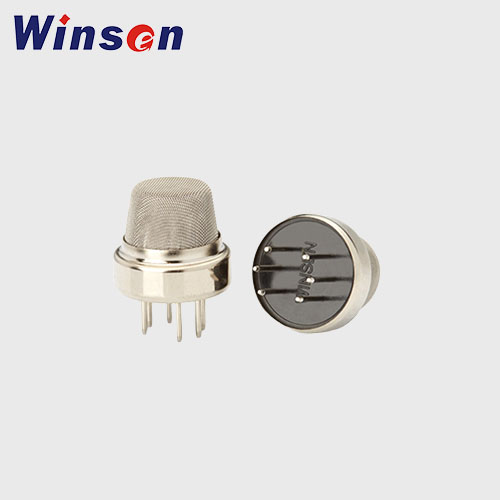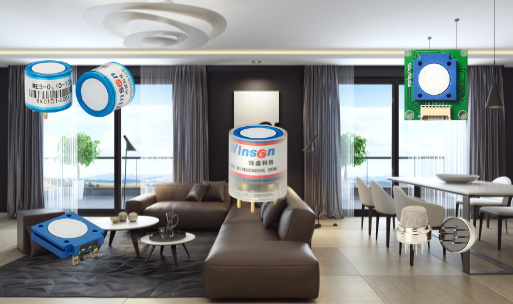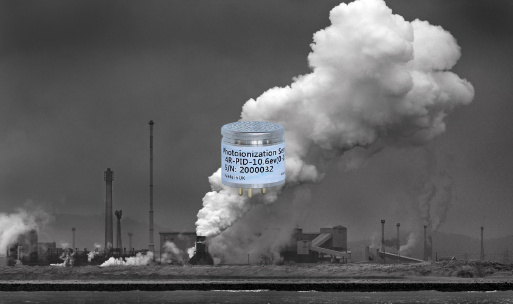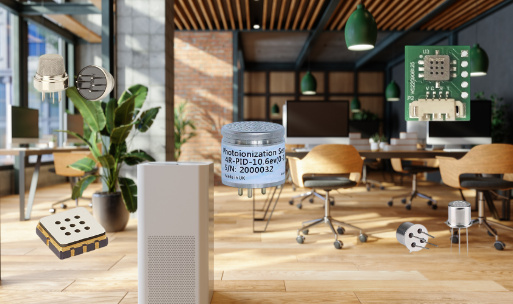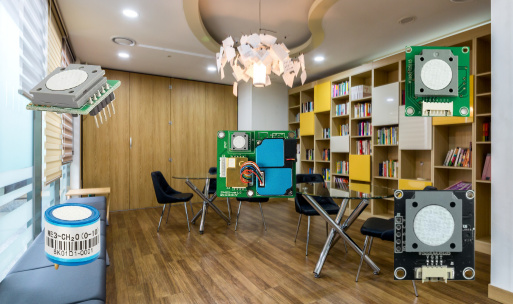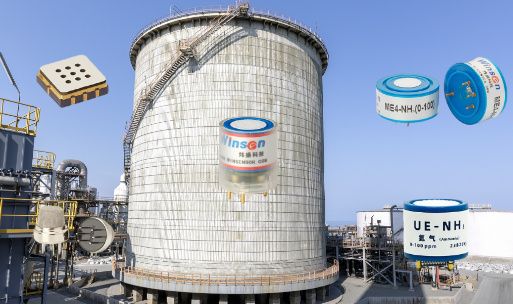Semiconductor O₃ Sensor (MOS Ozone Sensor) — Principles, Specifications, Applications, and Integration (Winsen OEM Guide)
1) What is a Semiconductor (MOS) Ozone Sensor?
A semiconductor ozone sensor uses a metal-oxide film (e.g., SnO₂-based or proprietary mixed oxides) whose surface chemistry changes in the presence of ozone (O₃). Ozone is a strong oxidizer; when it interacts with adsorbed oxygen species on the MOS surface, the charge carrier density and thus the film resistance shift. By biasing the sensing layer and measuring the resistance (or a conditioned voltage), you obtain a signal correlated to O₃ concentration.
Why MOS for O₃?
- Fast response (tens of seconds or faster) for event/odor/spike detection
- Compact, low cost, easy to embed in high-volume consumer or IAQ nodes
- Long service life with simple electronics and no consumable lamp/electrolyte
For compliance-grade or safety-critical ppm alarms, MOS should be complemented or replaced by electrochemical or UV photometric methods. For trend detection and household alerts, MOS is ideal.
2) How MOS O₃ Sensing Works (Signal Chain)
- Heated film activation: A micro-heater sets the sensing film to an operating temperature that promotes surface reactions.
- Gas–surface interaction: Ozone modifies the chemisorbed oxygen species and surface states, shifting conductivity.
- Readout: The sensor behaves like a variable resistor. Using a load resistor (voltage divider) or a constant-voltage/constant-current scheme, convert resistance to a measurable voltage for the ADC.
- Compensation & mapping: Apply temperature/humidity compensation, baseline tracking, and a calibration curve to map the raw signal to ppb/ppm, or to an IAQ/O₃ index.
3) Winsen MOS O₃ Portfolio (At a Glance)
| Model | Type | Recommended Range | Typical Use | Notes |
|---|---|---|---|---|
| ZQ02-O3 | Integrated MOS module | 10–1000 ppb | Household & IAQ alarms, event detection | On-board conditioning & alarm/buzzer; fast response (<~30 s), 5 V supply |
| MQ131-L | Discrete MOS sensing element (low-range) | ~10–1000 ppb | IAQ nodes, home detectors, DIY | Requires external conditioning (heater + divider + ADC) |
| MQ131-H | Discrete MOS sensing element (high-range) | ~10–1000 ppm | High-level/process ozone presence | Suited for high-ppm environments; external conditioning needed |
Exact ranges and response depend on circuit, heater power, enclosure, and compensation algorithms.
4) Performance Characteristics (Typical)
-
LOD & Range:
- ZQ02-O3 / MQ131-L: low-ppb to ~1 ppm class; suitable for indoor/ambient spikes and generator by-products.
- MQ131-H: up to hundreds of ppm for presence detection in process/disinfection applications.
-
Response/Recovery: < 30–60 s to step changes (application-dependent), faster with forced convection.
-
Repeatability: Good for relative trends; absolute accuracy depends on compensation and field calibration.
-
Lifetime: Multi-year in normal IAQ duty; sensitivity drifts slowly and is correctable via baseline routines.
-
Operating window: Wide temperature/RH tolerance; avoid condensation and corrosive aerosols.
5) MOS vs. Electrochemical vs. UV Photometric (Quick Comparison)
| Attribute | MOS (Semiconductor) | Electrochemical (EC) | UV Photometric |
|---|---|---|---|
| Sensitivity | ppb–ppm (good for IAQ/events) | ppb–ppm (higher accuracy) | ppb (reference-grade) |
| Response | Fast (seconds–tens of seconds) | Seconds–minutes | Seconds |
| Specificity | Broader cross-gas response | Higher selectivity | High selectivity |
| O&M | Very low | Low–medium (cal/bump) | Medium (optics/flow) |
| Cost/Size | Lowest / smallest | Small–medium | Larger / higher cost |
| Best For | Consumer/IAQ alarms, trends | Safety & process accuracy | Regulatory/precision |
6) Integration Guide
6.1 Electrical
- Heater drive: Stable 5 V or PWM-controlled power for MQ131 family; follow recommended warm-up.
- Load resistor (RL): Start with 10–100 kΩ; select to keep output in the ADC’s linear region across your expected O₃ window.
- ADC & supply: ≥ 10–12 bit ADC recommended; reference stability is key. Decouple sensor and heater with dedicated RC/LC filtering.
- Module option (ZQ02-O3): Use the module’s digital/alarm output and on-board buzzer to avoid analog front-end design.
6.2 Mechanical
- Airflow: Provide vent holes/diffusion path; avoid dead zones and direct jets. Small flow guides improve repeatability.
- Materials: Ensure ozone-compatible plastics (PTFE/PFA/PVDF/PA12) for inlets; avoid natural rubber and low-grade PVC.
- Condensation & dust: Add hydrophobic, dust-rated membranes where needed; avoid cleaning aerosols reaching the die.
6.3 Firmware & Algorithms
-
Warm-up masking: Ignore readings during initial 60–180 s (model/environment dependent).
-
Compensation: Real-time T/RH compensation (polynomial or LUT).
-
Baseline & drift control:
- Auto-baseline during low-ozone hours (night) if the environment periodically returns to clean air.
- Median / moving average (1–10 s) + rate-of-rise guards to capture events without chatter.
-
Scaling: For consumer UX, map to a 0–500 O₃/IAQ index with colored status; for industrial, provide ppb/ppm plus health flags.
7) Cross-Sensitivity & Interference
- Oxidizing gases: NO₂, Cl₂ can cause positive response; strong oxidants may amplify readings.
- VOC/solvents: Some MOS stacks show responses to alcohols/solvents—design your thresholds accordingly.
- Humidity & temperature: Large RH jumps alter surface kinetics; use on-board RH/T for compensation and apply dew-point protection.
- Aging/contamination: Long exposure to silicones, aerosols, or high O₃ may affect sensitivity; implement burn-in and periodic baseline refresh.
For mixed-oxidant outdoor monitoring or safety interlocks, consider dual-sensor strategies (e.g., MOS + EC) or use filters/scrubbers tuned to your interferents.
8) Calibration & Verification
- Factory alignment (modules): ZQ02-O3 ships with on-board conditioning; verify on site after installation.
- Field “fresh-air” zero: Establish/refresh baseline in low-ozone conditions; log temperature/RH at zero.
- Span checks: Use a reference instrument or controlled source to validate scaling (particularly for industrial set-points).
- Intervals: For consumer IAQ, baseline auto-correction may suffice; for stricter use, perform quarterly verification.
9) Recommended Use Cases & Model Selection
| Scenario | Recommended | Rationale |
|---|---|---|
| Home/office IAQ node (detect generator by-products, outdoor infiltration) | ZQ02-O3 or MQ131-L | Low-ppb sensitivity, fast event capture, low BOM |
| Wall-mount consumer alarm | ZQ02-O3 | Integrated conditioning + buzzer/alarm simplifies design |
| Maker/education projects | MQ131-L | Simple divider + ADC + heater drive; rich community examples |
| High-level ozone presence (disinfection rooms, process spaces) | MQ131-H | Extended ppm range for presence/threshold detection |
| Hybrid accuracy + cost | MOS + EC (e.g., ZQ02 + ZE25A) | Use MOS for fast spikes, EC for calibrated ppm logging |
10) Example Electrical Hookups
-
MQ131-L/H (discrete element):
- Heater @ 5 V (observe current spec), sense element as variable RS in series with RL to 5 V; measure Vout = f(RS).
- Add low-pass RC (~1–5 s) before ADC; oversample/average in firmware.
-
ZQ02-O3 (module):
- Supply 5 V, read digital status/alarm (and/or analog if provided by your version), optionally connect buzzer/LED or forward alarm to MCU/relay.
11) Safety & Compliance Considerations
- Alarm design: Use hysteresis + minimum on-time to avoid relay chatter. Document set-points (warning/action).
- Human exposure: Ozone is hazardous; indicate clear UI/labels and provide audible/visual alarms for consumer products.
- EMC & immunity: Follow EN 61326/61000-4-x good practices (filtering, grounding, shielding).
12) FAQs
Q1. Can MOS sensors report absolute ppb accurately?
A: They can be mapped to ppb/ppm with compensation and field verification, but they are best at relative trends and events. For tight accuracy/spec compliance, use EC/UV or hybridize.
Q2. How long is warm-up?
A: Typically 1–3 minutes to stabilize baseline; final optimization occurs over the first few hours of continuous operation.
Q3. Do cleaning sprays affect readings?
A: Yes—alcohols/aerosols cause short-term spikes. Add event masks after maintenance and avoid spraying near inlets.
Q4. Why two MQ131 variants?
A: MQ131-L targets ppb-level detection for IAQ; MQ131-H targets ppm-level presence in higher-concentration environments.
Q5. Can I place the sensor in a sealed box?
A: No. Provide venting and, if necessary, guided airflow to ensure representative sampling.
13) Why Choose Winsen for MOS O₃
- Complete lineup: From discrete MQ131-L/H to the ZQ02-O3 integrated module.
- Fast time-to-market: Reference circuits, compensation guidance, and compact footprints.
- Scalability: Stable supply, QC, and application engineering support for volume OEMs.
- Customization: Output mapping (analog/digital), housings, filters, and firmware thresholds tailored to your product.
Talk to Our Engineers
Share your target range, form factor, power/interface, and use case. We’ll recommend the optimal ZQ02-O3 / MQ131-L / MQ131-H configuration, provide reference designs & evaluation kits, and help you reach production with confidence.
